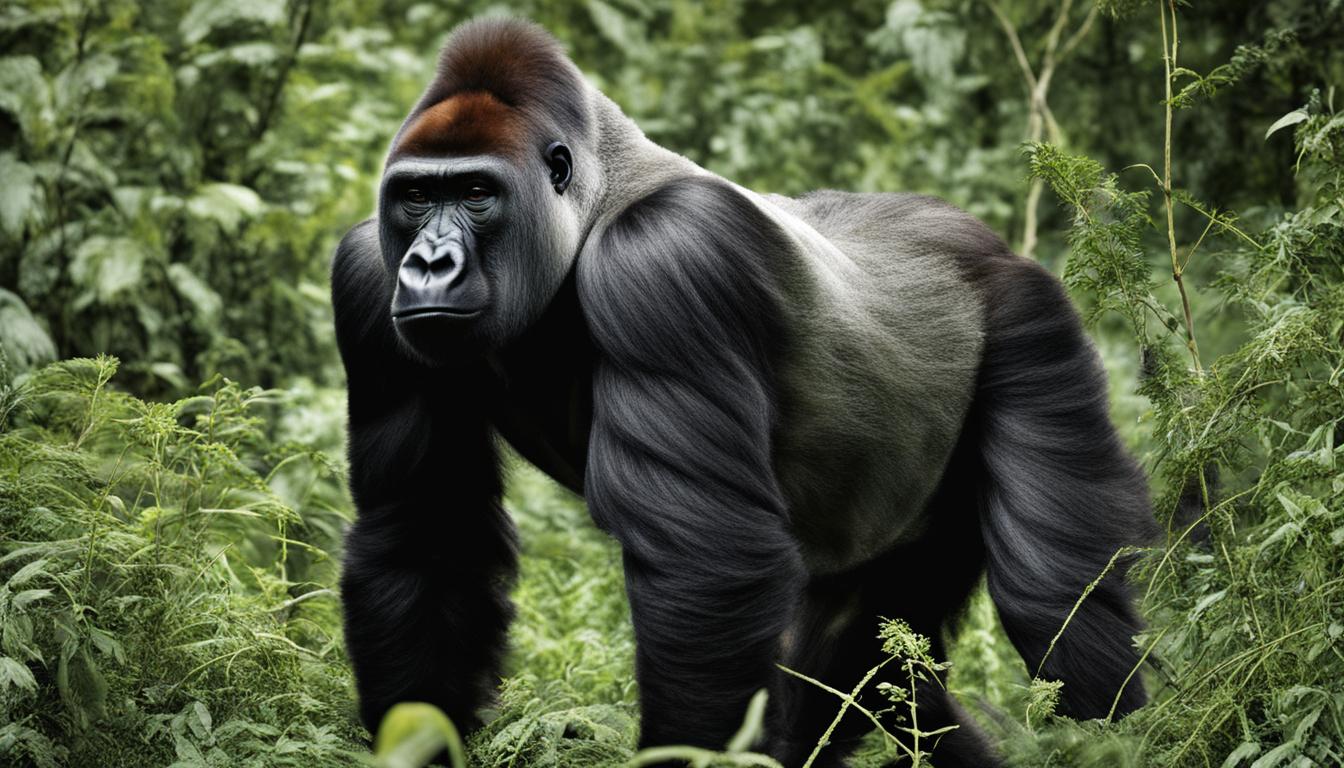Gorillas are herbivorous great apes native to the tropical forests of equatorial Africa. There are two species of gorillas – the eastern gorilla and the western gorilla. The total population of gorillas is estimated to be around 316,000 western gorillas and 5,000 eastern gorillas. Both species are classified as Critically Endangered by the IUCN, with the exception of the mountain gorilla, which is classified as Endangered.
Gorillas face threats such as poaching, habitat destruction, and disease, which have led to a decline in their numbers. It is crucial to understand the current population size and the challenges they face in order to develop effective conservation strategies and protect these endangered gorilla populations.
Factors impacting gorilla population
Gorillas, majestic creatures inhabiting the tropical forests of equatorial Africa, are facing numerous factors that are negatively impacting their population. One of the main threats to their existence is poaching, as these gentle giants are hunted for bushmeat, with their body parts and infants fetching high prices on the illegal wildlife trade market. In addition to poaching, another significant issue that gorillas face is habitat destruction. Deforestation and human encroachment have led to the loss of gorilla habitats, leaving them vulnerable and without sufficient resources for their survival.
Furthermore, diseases such as Ebola pose a grave risk to gorillas. These animals share close genetic similarities with humans, making them susceptible to the same diseases. Outbreaks of Ebola in gorilla populations have caused significant declines in their numbers and have had devastating effects on their social structures. The spread of disease is facilitated by the close contact between gorillas and humans, especially in areas where communities live in close proximity to gorilla habitats.
To combat these threats and ensure the conservation of gorilla populations, various efforts have been undertaken. Conservation organizations and local communities have joined forces to establish protected areas, where gorillas can thrive without the fear of poaching and habitat destruction. Anti-poaching measures, such as increased surveillance and the implementation of stricter laws, have been put in place to reduce the illegal wildlife trade. Community-based conservation programs have also been initiated, engaging local communities in the protection of gorillas and their habitats.
Gorilla Conservation Efforts
Protecting gorilla habitats is a crucial aspect of conservation efforts. By implementing habitat protection and restoration projects, conservationists aim to create suitable living conditions for gorillas, ensuring the long-term survival of these magnificent creatures. Such projects involve planting native trees, promoting sustainable land-use practices, and providing alternative livelihoods for local communities to reduce their dependence on the natural resources found within gorilla habitats. Additionally, raising awareness about the importance of gorilla conservation is essential to garner support and foster a sense of responsibility among individuals and communities.
Through collaborative efforts, including research, community involvement, and international cooperation, the conservation of gorilla populations can be achieved. Together, we can work towards protecting these remarkable animals and their habitats, ensuring a future where they can thrive in the wild.
| Threats | Impact | Conservation Efforts |
|---|---|---|
| Poaching | Reduces gorilla population | Establishment of protected areas, anti-poaching measures |
| Habitat destruction | Loss of gorilla habitats | Habitat protection and restoration projects, sustainable land-use practices |
| Disease | Mortality and population decline | Monitoring and surveillance, community-based conservation programs |
Gorilla Population Trends
Researchers and conservation organizations are dedicated to studying and analyzing the population trends of gorillas to gain insights into their overall health and viability. Through population surveys and studies, valuable data is collected on gorilla behavior, reproduction rates, and habitat quality, which are crucial for informing conservation strategies. Examining the dynamics of gorilla populations allows conservationists to identify areas where additional efforts are needed to protect and preserve these magnificent creatures.
Gorilla Population Research
Gorilla population research involves conducting extensive studies and surveys to estimate the number of gorillas in the wild. Researchers use various methods, such as direct observations, camera traps, and genetic analysis, to gather accurate data on gorilla populations. This research provides valuable information on population sizes, distributions, and trends over time, helping conservationists assess the effectiveness of conservation efforts and develop targeted conservation strategies.
Gorilla Population Analysis
Population analysis plays a vital role in understanding the dynamics and health of gorilla populations. By analyzing factors such as population density, age structure, and reproductive rates, researchers can assess the overall population growth or decline. This analysis provides valuable insights into the factors influencing gorilla populations, such as habitat loss, poaching, and disease. It helps conservation organizations prioritize conservation actions and allocate resources effectively to ensure the long-term survival of gorillas.
Gorilla Population Dynamics
Gorilla population dynamics refer to the changes and fluctuations in the size and structure of gorilla populations over time. These dynamics are influenced by various factors, including natural fluctuations, environmental changes, and human activities. In-depth analysis of population dynamics helps researchers understand the underlying reasons for population changes, identify potential threats, and develop strategies to mitigate them. By monitoring and studying gorilla population dynamics, conservationists can make informed decisions to protect and conserve these endangered species.

Gorilla Population by Species and Subspecies
Gorillas are divided into two species – the western gorilla and the eastern gorilla. Each species is further classified into several subspecies. Let’s take a closer look at the population distribution of gorillas by species and subspecies:
Western Gorilla
The western gorilla (Gorilla gorilla) is divided into four or five subspecies, including:
- Western lowland gorilla (Gorilla gorilla gorilla): The western lowland gorilla is the most numerous of all gorilla subspecies. It is found in the forests of Central Africa, primarily in Cameroon, Equatorial Guinea, Gabon, and the Republic of Congo. The population of western lowland gorillas is estimated to be around 225,000 individuals.
- Cross River gorilla (Gorilla gorilla diehli): The Cross River gorilla is the most endangered gorilla subspecies. It is found in the mountainous rainforests of Nigeria and Cameroon. The population of Cross River gorillas is estimated to be less than 300 individuals.
Eastern Gorilla
The eastern gorilla (Gorilla beringei) has two subspecies:
- Mountain gorilla (Gorilla beringei beringei): The mountain gorilla is the most famous and iconic gorilla subspecies. It inhabits the high-altitude forests of the Virunga Massif, which spans across Rwanda, Uganda, and the Democratic Republic of Congo. The population of mountain gorillas is estimated to be around 1,063 individuals.
- Grauer’s gorilla (Gorilla beringei graueri), also known as the eastern lowland gorilla: Grauer’s gorilla is the largest gorilla subspecies. It is found in the lowland forests of the eastern Democratic Republic of Congo. The population of Grauer’s gorillas is estimated to be around 3,800 individuals.
| Species/Subspecies | Estimated Population |
|---|---|
| Western lowland gorilla | 225,000 |
| Cross River gorilla | Less than 300 |
| Mountain gorilla | 1,063 |
| Grauer’s gorilla (Eastern lowland gorilla) | 3,800 |
These population estimates are based on research and monitoring efforts conducted by conservation organizations and researchers. It is worth noting that gorilla populations are constantly changing due to various factors, including conservation efforts, habitat loss, and poaching. The conservation of each species and subspecies is crucial to ensure the long-term survival of gorillas in the wild.
Gorilla population distribution and habitat
Gorillas primarily inhabit the tropical forests of equatorial Africa, with their natural range covering a small percentage of Sub-Saharan Africa. They can be found in a wide range of elevations, from lowland swamps to montane cloud forests. The distribution of gorillas is determined by the availability of suitable habitats, including forests with abundant food sources and suitable vegetation for nesting.
The mountain gorilla, a subspecies of the eastern gorilla, resides in the montane cloud forests of the Virunga Volcanoes at elevations ranging from 2,200 to 4,300 meters. This unique habitat provides the perfect conditions for mountain gorilla populations to thrive. On the other hand, lowland gorillas, such as the western lowland gorilla, inhabit dense forests and lowland swamps as low as sea level.
Gorilla habitat conservation plays a crucial role in ensuring their long-term survival. Protecting and preserving these habitats are essential for maintaining healthy gorilla populations. Efforts are being made to establish protected areas, promote sustainable land use practices, and mitigate the impact of deforestation and human encroachment on gorilla habitats.
Conservation efforts for gorilla population
Various organizations and conservation initiatives are dedicated to protecting and conserving gorilla populations. They work towards preserving gorilla habitats, implementing anti-poaching measures, conducting research and population monitoring, and raising awareness about the importance of gorilla conservation. These efforts involve collaboration with local communities, governments, and international stakeholders to ensure the long-term survival of gorillas. Programs such as eco-tourism and gorilla trekking provide sustainable income for local communities while promoting the conservation of gorilla populations.
Gorilla conservation organizations play a crucial role in the preservation of these majestic creatures. Through their work, they strive to address the key threats faced by gorillas, such as poaching and habitat loss. These organizations also focus on educating local communities about the importance of gorilla conservation and engaging them in conservation efforts. By involving communities in the conservation process, organizations can create a sense of ownership and cultivate sustainable practices that benefit both humans and gorillas.
One example of a gorilla conservation organization is the Dian Fossey Gorilla Fund International. Named after renowned primatologist Dian Fossey, this organization is dedicated to the protection and study of gorillas in Africa. They conduct long-term research, engage local communities in conservation, and work to prevent poaching and illegal activities. Their efforts have contributed significantly to the conservation and well-being of gorilla populations.
The Dian Fossey Gorilla Fund International Conservation Programs
- Gorilla protection and monitoring
- Anti-poaching patrols and law enforcement
- Community-based conservation initiatives
- Habitat restoration and protection
- Education and awareness programs
These are just a few examples of the conservation efforts being made to protect gorilla populations. With continued support and collaboration, we can ensure a future for gorillas in their natural habitats and contribute to the overall preservation of biodiversity.
Captive gorilla populations
While most of the gorilla population resides in the wild, there are also gorillas that live in captivity in zoos and sanctuaries around the world. These captive gorillas, primarily western lowland gorillas, play a crucial role in education, research, and conservation efforts.
One of the key benefits of having captive gorilla populations is their ability to serve as ambassadors for their species. Visitors to zoos and sanctuaries can observe these magnificent creatures up close, raising awareness about the importance of protecting wild gorilla populations. Seeing gorillas in person can create a profound connection and inspire individuals to take action in their conservation.
“Seeing gorillas in person can create a profound connection and inspire individuals to take action in their conservation.”
Zoos and sanctuaries also prioritize the care and well-being of their captive gorillas. They provide essential support, including proper nutrition, medical care, and enrichment activities to stimulate their physical and mental health. These efforts ensure that the captive gorillas live fulfilling lives and thrive in their controlled environments.
Overall, captive gorillas play a vital role in conservation efforts, fostering public engagement, and providing valuable research opportunities. By showcasing the beauty and importance of these incredible creatures, they contribute to the collective efforts to protect gorillas and their natural habitats.
Table: Comparison of Captive Gorilla Population in Selected Zoos
| Zoo Name | Location | Number of Gorillas |
|---|---|---|
| San Diego Zoo | San Diego, California | 12 |
| Smithsonian National Zoo | Washington, D.C. | 9 |
| Toronto Zoo | Toronto, Canada | 6 |
| Singapore Zoo | Singapore | 5 |
Note: The table above provides a comparison of the captive gorilla populations in selected zoos. The numbers represent an approximate count and may vary over time.
Conclusion
Gorillas are magnificent creatures that are facing significant threats to their survival. Poaching, habitat destruction, and disease have led to a decline in their numbers. However, there is hope for their conservation as efforts to protect gorilla populations are showing promising results.
To ensure the long-term survival of gorillas, it is crucial to continue supporting conservation initiatives. By contributing to gorilla conservation efforts, you can help protect these incredible animals and the habitats they rely on.
Protecting gorillas is not just about preserving a species; it is also about safeguarding the biodiversity of our planet. Gorillas play a vital role in their ecosystems, promoting forest regeneration and maintaining a balance in their habitats. By protecting gorillas, we are also preserving the future of other species that share their habitats.
Together, we can make a difference. Join the fight to protect gorillas and ensure a future where these remarkable creatures thrive in the wild. Your support can help secure a better tomorrow for gorilla populations and contribute to the conservation of our natural world.
How are Diseases Affecting the Population of Wild Gorillas?
Diseases affecting wild gorillas have led to a decline in their population. Human viruses like Ebola and respiratory infections have caused significant deaths among these primates. Conservation efforts are focusing on minimizing human-gorilla interactions and implementing health monitoring programs to protect the remaining population from further impact.
FAQ
How many gorillas are left in the wild?
The total population of gorillas is estimated to be around 316,000 western gorillas and 5,000 eastern gorillas.
What are the main factors impacting gorilla population?
Gorilla populations are threatened by poaching, habitat destruction, and disease.
What is being done to protect gorilla populations?
Numerous conservation efforts have been initiated, including the establishment of protected areas, anti-poaching measures, and community-based conservation programs.
How are gorilla populations monitored and studied?
Researchers and conservation organizations conduct population surveys and studies to estimate gorilla numbers and analyze population dynamics.
How is the gorilla population divided by species and subspecies?
There are two species of gorillas – the western gorilla and the eastern gorilla – each with several subspecies.
Where do gorillas live and what is their habitat like?
Gorillas inhabit the tropical forests of equatorial Africa and can be found in a range of elevations, from lowland swamps to montane cloud forests.
What are some organizations dedicated to gorilla conservation?
Various organizations and conservation initiatives work towards protecting and conserving gorilla populations, collaborating with local communities, governments, and international stakeholders.
Are there gorillas in captivity?
Yes, some gorillas live in captivity in zoos and sanctuaries around the world, contributing to education, research, and conservation efforts.
What should be done to protect gorillas?
To protect gorillas, it is crucial to continue supporting conservation initiatives, raising awareness, and implementing measures to protect their habitats.







